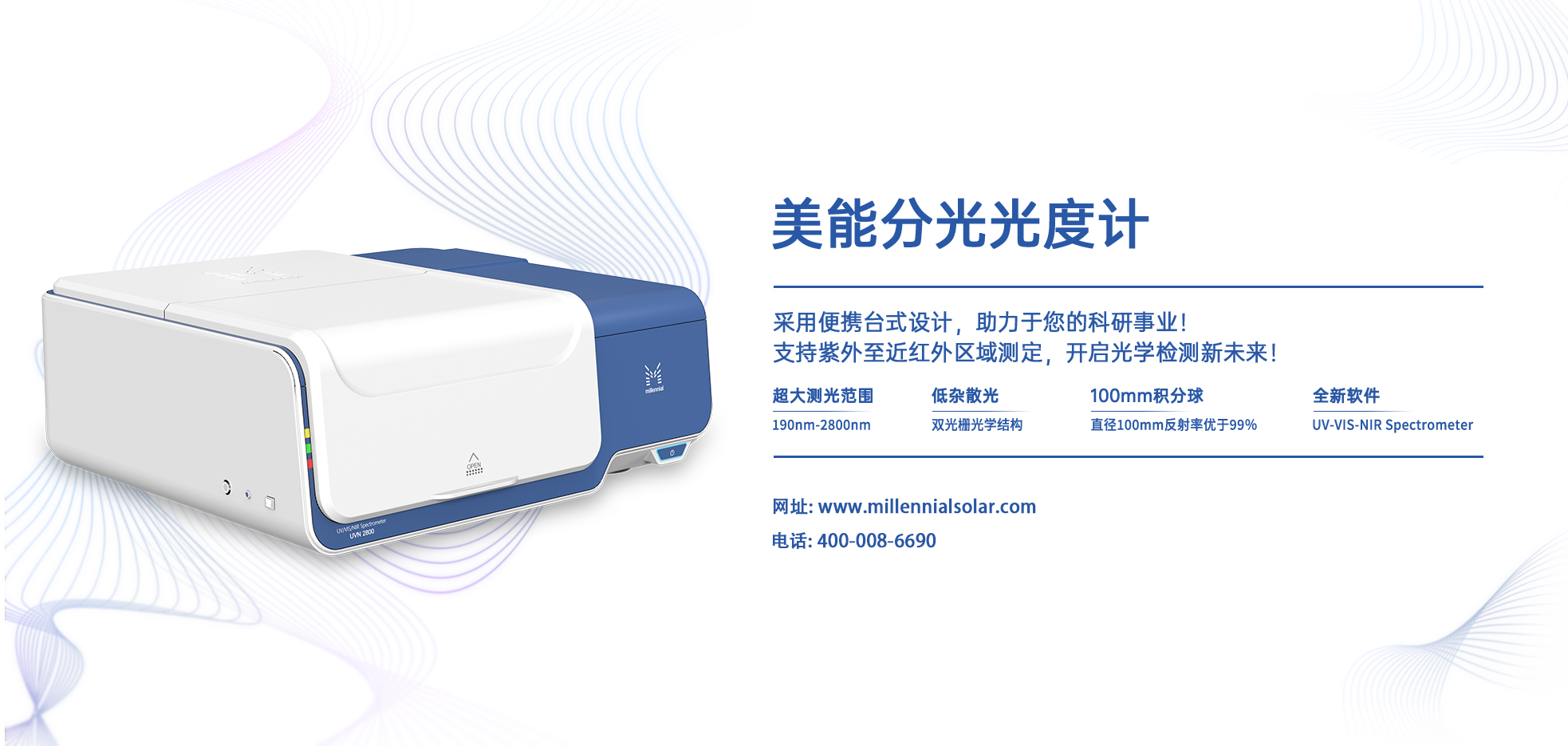
量子效率测试仪
PL/EL一体机
Sinton硅片少子寿命测试仪
Sinton硅块少子寿命测试仪
绒面反射率测试仪
3D共聚焦显微镜
清洗制绒工作站
在线四探针方阻测试仪
全自动扫描四探针方阻测试仪
在线薄膜厚度测试仪
晶化率测试仪
Horiba显微共焦拉曼光谱仪
傅里叶红外光谱仪
霍尔效应测试仪
分光光度计
全光谱椭偏仪
Horiba椭圆偏振光谱仪
TLM接触电阻率测试仪
超景深显微镜
网版智能影像测量仪
全自动影像测量仪
卧式拉力机
电池片稳态光衰老化试验箱
电池片紫外老化试验箱
电池片拉脱力综合测试仪
外观检验台
湿漏电测试系统
组件实验室EL测试仪
紫外老化试验箱
稳态光衰老化试验箱
电流连续性监测系统
PID测试系统
旁路二极管测试系统
LeTID测试系统
反向电流过载系统
脉冲电压测试系统
绝缘耐压测试仪
接地连续性测试仪
绝缘耐压接地测试仪
湿热环境试验箱
湿冻环境试验箱
热循环试验箱
动态机械载荷测试机
静态机械载荷测试机
冰雹冲击试验机
引出端强度试验机
霰弹冲击试验机
抗划伤(切割)测试机
剥离试验机
万能材料试验机(单臂)
万能材料试验机(双臂)
光伏玻璃透过率测试仪
醋酸测试试验箱
交联度测试系统
二极管接线盒综合测试仪
落球冲击试验机
半自动四探针
全自动探针式台阶仪
多通道太阳能MPPT系统
Horiba稳瞬态荧光光谱仪
钙钛矿P1激光划线测试仪
钙钛矿在线膜厚测试仪
钙钛矿工艺检测工作站
手持式IV测试仪
便携式EL测试仪
手持热成像测试仪
户外组件IV测试仪
户外组件多通道测试系统
光伏逆变器电能质量测试仪
无人机EL检测仪
美能光伏产品 | 精确有效的高性能薄膜检测仪器——美能分光光度计
日期:2023-10-13浏览量:10
为了保证太阳能电池在沉积ITO薄膜后达到理想的透光率和反射率,电池厂商通常会在沉积工艺结束后,使用高精密的检测设备进行科学检测,从而间接保障太阳能电池在投入实际应用时的输出功率稳定、性能稳定高效。「美能光伏」为助力电池厂商在生产太阳能电池时科学的评估其性能是否符合沉积工艺的生产标准,生产了可高效与科学的检测沉积薄膜透光率的美能分光光度计,该设备采用了全新控制数据处理功能,并根据科学性的技术原理使分析更加流畅、操作更为便捷!

![]()
美能分光光度计——提供精确稳定的性能评估
美能分光光度计是一款用于测量ITO薄膜及各种类型薄膜与物质的透光率、反射率和吸光度,从而帮助电池厂商有效评估太阳能电池片光电转换率的高精密检测设备,该设备采用了最先进的四区分段扇形信号收集斩波器,斩波器运转期间,可使样品和参比的信号分别单独的被各自的黑区信号所分隔并校正,确保了每次得到最精准的检测数据。

四区分段扇形信号收集斩波器
美能分光光度计提供的直径100mm的积分球,使用了光学聚四氟乙烯涂层,涂层在可见区的反射率接近100%,并且在长期使用中可保证不发黄变性,光学性能稳定,从而为太阳能电池的效率分析提供了有力支持。
![]()
独特的光学技术、强大的仪器性能

美能分光光度计采用了独特的双光束光学设计,可大幅度降低在测试过程中,检测设备对太阳能电池片基底的干扰。在太阳能电池的沉积工艺中,美能分光光度计可完美矫正薄膜沉积后太阳能电池片基底的吸光度变化,从而稳定地进行样品的测定。美能分光光度计支持测定从紫外区到近红外区的广范围波长区域的太阳光透过率,并且保障在对太阳能电池的质量检测时有效的降低杂散光,从而实现高精度测量。
![]()
满足多种薄膜测试需求、实现针对性性能检测
由于太阳能电池的种类繁多,因此在投入实际使用前所选择的薄膜材料也需因种类的不同而有所变化。其中,应用较多的便是ITO薄膜,ITO薄膜可作为透明导电层与电极等,从而将太阳能电池片吸收的太阳能光转换为电能,保护和增强太阳能电池的性能。

不同波段下的透过率与反射率
因此ITO薄膜必须具有合适的电学性能和光学性能,而电学性能和光学性能是相互影响的,必须同时优化才能使太阳能电池的输出功率达到理想效果。美能分光光度计提供的190-2800nm范围的紫外可见近红外测量区域,可完全满足在300-1200nm全波段采集ITO薄膜的反射率、透过率数据的需求,并根据数据处理功能生成的实时数据与二维图谱,帮助电池厂商有效优化沉积ITO薄膜及各种类型的薄膜材料时太阳能电池的性能,助力其高效生产!
对一件成品进行质量检测与保障对于各行各业而言都是极为重要的事情,一块没有经过检测的太阳能电池,倘若只凭借理论化的推理便投入实际应用,那么所遇到的问题往往是后续难以弥补或调整的。「美能光伏」为了帮助电池厂商生产理想的太阳能电池,提供了美能分光光度计等众多检测太阳能电池从生产到结束的高性能检测设备,助力电池厂商对太阳能电池进行高效生产与科学评估!




































































